
(Houston, Texas) – According to Houston area supply chain executives, economic activity in Houston contracted for the month of April, with manufacturing contracting and non-manufacturing indicating moderate contraction. The overall economy expanded for the 59th month.
The Houston Purchasing Managers Index contracted to 48.5 points. The lead times index, one of the three indicators with a strong positive correlation with the economy, shifted from contracting to expanding in the month of April, rising 3.5 points to 53.1 points. The other indexes with strong positive correlation, sales/new orders and employment, contracted in April. The employment index fell 4.9 points to 45.5 points, flipping from expansion to contraction. The sales/new order index saw deeper contraction in April, dropping 0.1 points to 49.3 points. The finished goods inventory index, the underlying indicator that has the strongest inverse correlation with economic activity, decreased 1.8 points to 50.7 points; however, it still saw expansion.
The Houston Manufacturing PMI rose 1.7 points during the month; however the sector still saw contraction. The nonmanufacturing PMI decreased 1.7 points to 48.5 points, switching from expansion to contraction. The three-month forecast for the overall indicates we will see a slow climb to expansion driven by expansion in the manufacturing sector, while the nonmanufacturing sector will continue to slightly contract.
On an industry specific basis, health care, and trade, transportation and warehousing reported strong expansion. Oil and gas extraction and real estate indicated significant contraction.
Click here for the hard copy version of the report.
Indices at a Glance

Houston PMI Trend
Houston PMI readings over 50 generally indicate that respondents see their activities as expanding. An HPMI above 45 normally correlates with expansion of the Houston-The Woodlands-Sugar Land Business Cycle Index (H-BCI).

Commodities Reported to have Notable Price Changes or to be in Short Supply
Up in Price: Chemicals and gases, caustic; rotating equipment, fabricated equipment, carbon steel, steel-based products, electrical gear, electrical equipment, technical materials, investment castings, aluminum, copper, cobalt, cement
Down in Price: Crude oil; motor fuels, natural gas, natural gas liquids, ethane, propane, isobutane, natural gasoline, naphtha, ethylene, propylene, polypropylene resins; stainless steel, carbon steel, silver, aluminum, copper, nickel, lumber; ocean dry bulk freight, ocean container freight
In Short Supply: Instrumentation and electrical craft labor, skilled labor; automation equipment, instrumentation equipment, electrical equipment, electrical gear, electrical components
‡ reported as up or down by different respondents
What our Respondents are Saying
Oil and Gas Exploration, and Key Support Services:
- Significant effort is taking place to analyze tariff impacts and develop mitigation options
- Tarriff impacts are still somewhat unknown, and we are reviewing potential strategies
- Tariffs are increasing all steel-based product prices
- Crude oil prices continue to see downward pressure
- This sector continued to contract in April; the prices, lead time and full goods inventory indexes all indicated expansion. All other indexes contracted significantly
Construction:
- We are working through tariff impacts on projects; additional costs and potential lead time impacts are anticipated
- Many nuclear power projects are in development in the US and globally; supply chain capability to support this work is limited and will require substantial development/expansion
- April saw further reductions in fuel prices
- This sector pointed to slight contraction in April driven by slight weakness in the sales, production and employment indexes
Durable Goods Manufacturing:
- ·The tariff situation is increasing costs and lead times
- Durable goods saw slight expansion in April with strong sales and production. There was slight contraction in the employment, purchase and lead time indexes
Non-durable Goods Manufacturing:
- Olefins cracker feedstock prices continue to fall
- This sector reported contraction in April, the sales index indicated slight contraction; however, the employment and purchased inventory indexes reported significant weakness
Wholesale and Retail Trade:
- Customers are producing more due to pending tariffs
- Ocean container freight prices from Asia have fallen considerably since the beginning of the year
- This sector’s performance indicated expansion for the month of April, with strong expansion in most indexes. The employment, and lead time indexes did see slight contraction
Transportation and Warehousing:
- Houston air passenger traffic rose significantly in March consistent with normal seasonal changes
- This sector indicated strong expansion in April with only employment pointing to slight contraction. All other indexes indicated expansion
Professional and Business Services:
- This past month seems to have reset the reality of business economic conditions
- After the first of the year, there was hope that the business would pick up and companies would be adding to staff; that enthusiasm has diminished over the past several weeks
- Companies are still cautious about excessive hiring
- The recent discussions and situation around tariffs have significantly increased economic evaluation efforts; it appears that companies are not going to make any significant market changes until these discussions clear the air
- Tariffs have had a major impact on our business since companies are holding off in making decisions on staffing requirements
- Prices that are being paid for both hourly work and direct hire salaries remain stable with not much movement either way
- This sector’s performance indicated slight contraction during the month with diminished sales, production and employment. The lead time index also indicated a slight contraction
Trend of Underlying Indicators
The Houston PMI is based on diffusion indices for eight underlying indicators. The net value of each indicator is simply the percentage of respondents who cite a positive shift from the previous month minus the percentage who cite a negative shift. The diffusion index is calculated based on the percent of respondents reporting higher results plus one-half of those responding the same with seasonal adjustments to the Sales/New Orders, Production, Employment, and Prices Paid indices based on an X13 ARIMA forecast. Values above 50 for Sales/New Orders, Production, Employment, Prices Paid, and Lead Times generally point towards expansion and values below 50 signal contraction. Note that the Prices Paid Index may not follow this trend late in an economic expansion. The Inventory measures have an inverse correlation at most forecast horizons, meaning that values below 50 point to expansion and values above point to contraction. The Purchases index is inversely correlated with economic activity at the three-month forecast horizon.
Sales/New Orders (Seasonally Adjusted)
The sales index saw faster contraction in April vs March. This was driven by a sharp decline in the manufacturing sector. Nonmanufacturing contracted at a slower rate than March.
| Higher | Same | Lower | Net | Index | |
| Nov/24 | 19% | 74% | 7% | 12% | 59.8 |
| Dec/24 | 18% | 76% | 6% | 12% | 58.2 |
| Jan/25 | 22% | 74% | 4% | 18% | 57.3 |
| Feb/25 | 16% | 81% | 3% | 13% | 53.6 |
| Mar/25 | 14% | 74% | 12% | 2% | 49.4 |
| Apr/25 | 16% | 71% | 13% | 3% | 49.3 |
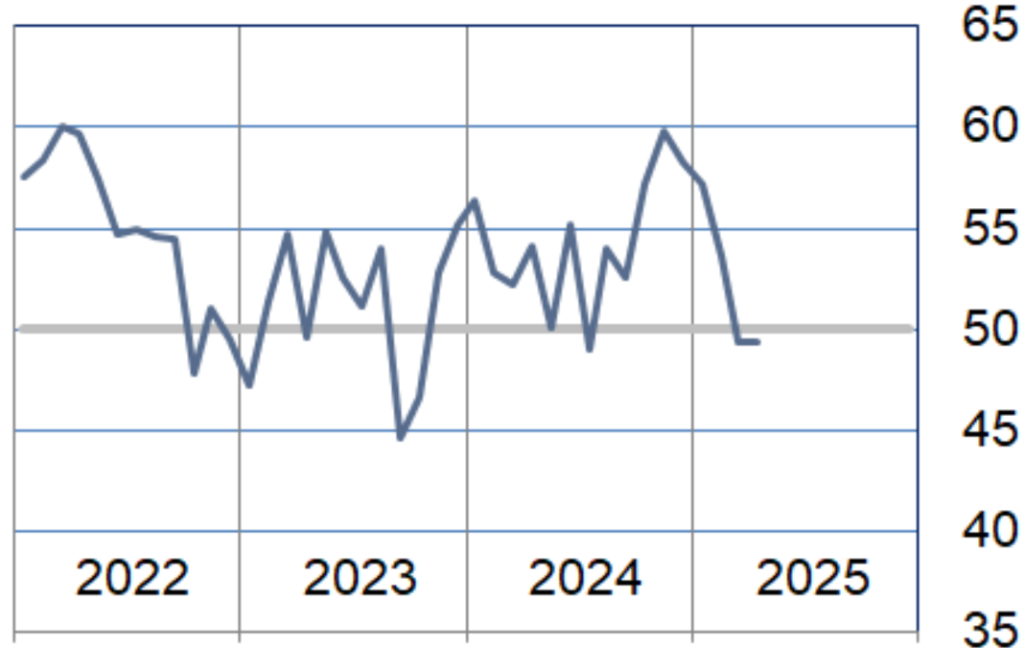
Production Index (Seasonally Adjusted)
The production index returned to expansion. It was propelled by the manufacturing sector which expanded at a much faster rate in April vs March. Nonmanufacturing stayed virtually flat at slight contraction.
| Higher | Same | Lower | Net | Index | |
| Nov/24 | 14% | 80% | 6% | 8% | 56.1 |
| Dec/24 | 10% | 85% | 5% | 5% | 52.9 |
| Jan/25 | 13% | 82% | 5% | 8% | 53.2 |
| Feb/25 | 6% | 91% | 3% | 3% | 50.6 |
| Mar/25 | 8% | 85% | 7% | 1% | 49.2 |
| Apr/25 | 8% | 85% | 7% | 1% | 50.0 |
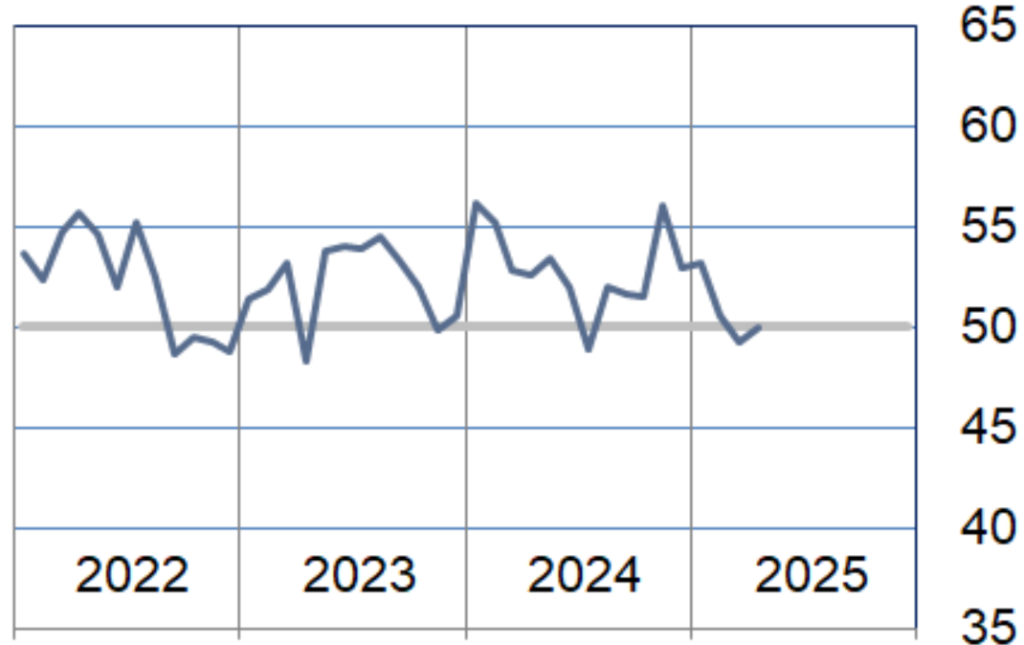
Employment Index (Seasonally Adjusted)
The employment index contracted switched from expansion to contraction driven by a sharp decline in the nonmanufacturing sector going from expansion to moderate contraction.
| Higher | Same | Lower | Net | Index | |
| Nov/24 | 8% | 85% | 7% | 1% | 50.7 |
| Dec/24 | 6% | 91% | 3% | 3% | 50.3 |
| Jan/25 | 3% | 94% | 3% | 0% | 48.5 |
| Feb/25 | 2% | 93% | 5% | -3% | 47.5 |
| Mar/25 | 9% | 83% | 8% | 1% | 50.4 |
| Apr/25 | 5% | 84% | 11% | -6% | 45.5 |
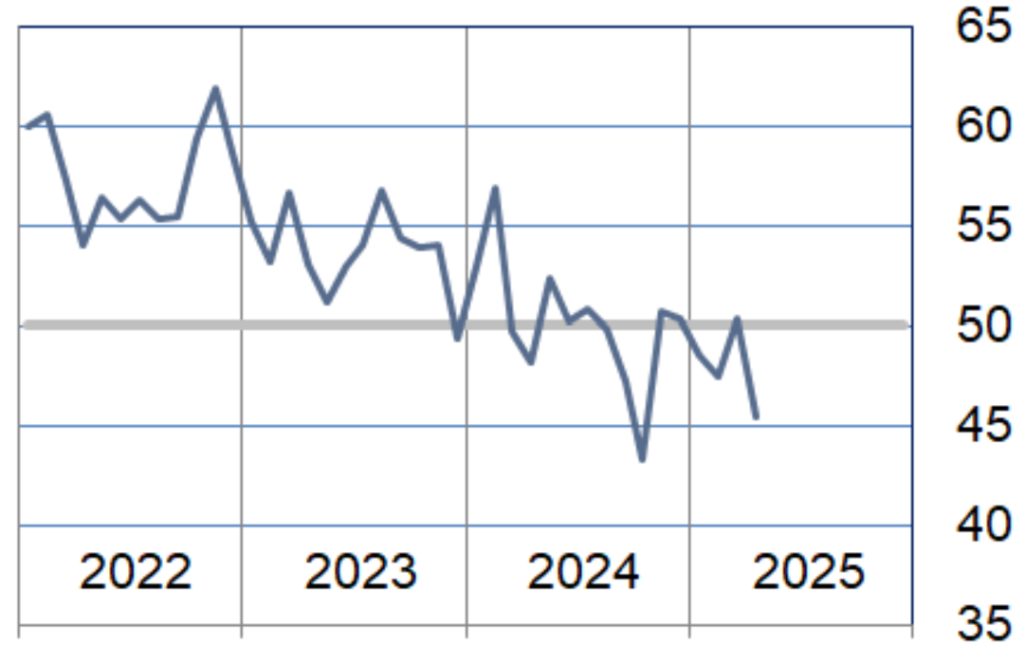
Purchases Index (Not Seasonally Adjusted)
The purchase index continues to expand and did so at a faster rate driven by nonmanufacturing shifting from contraction to moderate expansion.
| Higher | Same | Lower | Net | Index | |
| Nov/24 | 9% | 84% | 7% | 2% | 50.7 |
| Dec/24 | 7% | 87% | 6% | 1% | 50.6 |
| Jan/25 | 25% | 73% | 2% | 23% | 59.4 |
| Feb/25 | 23% | 75% | 2% | 21% | 59.2 |
| Mar/25 | 11% | 80% | 9% | 2% | 50.0 |
| Apr/25 | 19% | 73% | 8% | 11% | 52.6 |

Prices Paid Index (Seasonally Adjusted)
The prices paid index saw a sharp increase vs March. Both the manufacturing and nonmanufacturing sector saw significant expansion.
| Higher | Same | Lower | Net | Index | |
| Nov/24 | 9% | 87% | 4% | 5% | 51.6 |
| Dec/24 | 13% | 82% | 5% | 8% | 52.2 |
| Jan/25 | 15% | 83% | 2% | 13% | 56.1 |
| Feb/25 | 33% | 65% | 2% | 31% | 63.5 |
| Mar/25 | 13% | 76% | 11% | 2% | 48.8 |
| Apr/25 | 18% | 79% | 3% | 15% | 56.5 |

Lead Times Index (Not Seasonally Adjusted)
Along with prices paid, the lead time index both the manufacturing and nonmanufacturing sector expand significantly in April. The nonmanufacturing sector flipped from contraction to expansion.
| Higher | Same | Lower | Net | Index | |
| Nov/24 | 3% | 93% | 4% | -1% | 49.6 |
| Dec/24 | 2% | 90% | 8% | -6% | 47.0 |
| Jan/25 | 5% | 91% | 4% | 1% | 53.2 |
| Feb/25 | 3% | 95% | 2% | 1% | 49.5 |
| Mar/25 | 8% | 89% | 3% | 5% | 49.6 |
| Apr/25 | 11% | 87% | 2% | 9% | 53.1 |

Purchased Inventory Index (Not Seasonally Adjusted)
The purchased inventory index contracted at a slower rate in April, driven by the nonmanufacturing sector approaching neutral vs the previous month. Manufacturing contracted at a faster rate than March.
| Higher | Same | Lower | Net | Index | |
| Nov/24 | 2% | 94% | 4% | -2% | 48.8 |
| Dec/24 | 2% | 91% | 7% | -5% | 47.5 |
| Jan/25 | 5% | 93% | 2% | 3% | 49.6 |
| Feb/25 | 6% | 87% | 7% | -1% | 51.2 |
| Mar/25 | 6% | 87% | 7% | -1% | 47.8 |
| Apr/25 | 2% | 93% | 5% | -3% | 48.7 |

Finished Goods Inventory Index (Not Seasonally Adjusted)
The finished goods inventory expanded at a slower rate in April. The nonmanufacturing sector was flat month over month (slight expansion) but the manufacturing sector saw a significant slowing of expansion.
| Higher | Same | Lower | Net | Index | |
| Nov/24 | 3% | 93% | 4% | -1% | 49.1 |
| Dec/24 | 2% | 94% | 4% | -2% | 48.7 |
| Jan/25 | 5% | 93% | 2% | 3% | 51.4 |
| Feb/25 | 6% | 88% | 6% | 0% | 49.9 |
| Mar/25 | 7% | 91% | 2% | 5% | 52.5 |
| Apr/25 | 5% | 91% | 4% | 1% | 50.7 |
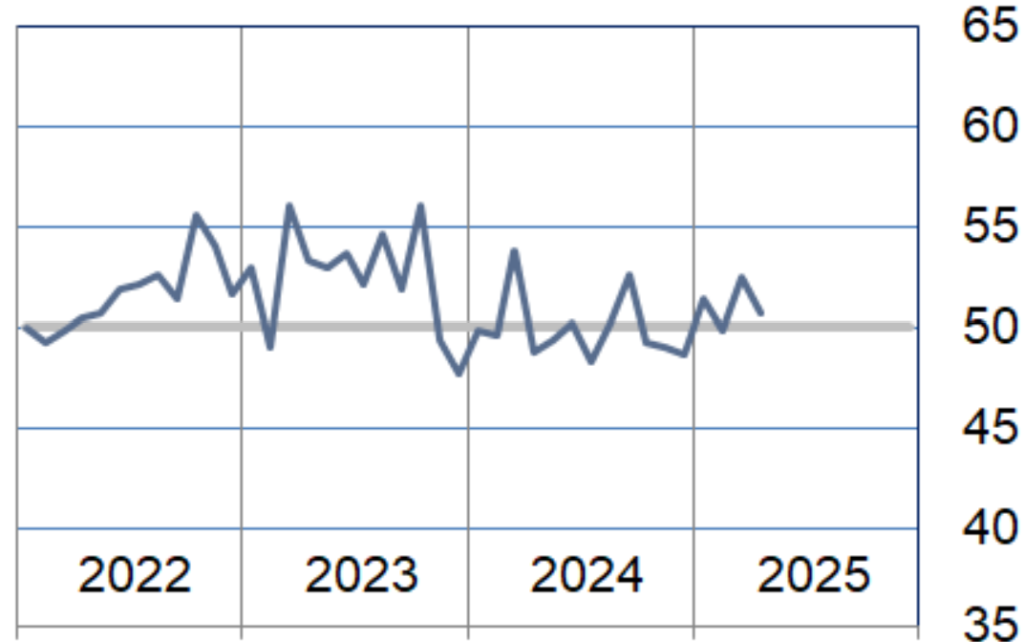
Projections for Key Long-Term Indicators
In addition to the current status of business activities, respondents to the ISM-Houston Business Survey also provide feedback on their view of the direction of the sales/new orders and employment indices six months into the future.
Six-Month Projection of the Sales/New Orders Index
The future sales index showed a sharp decline for the manufacturing sector vs March. The nonmanufacturing sector saw a moderate slowing; however, still indicates expansion.
| Higher | Same | Lower | Net | Index | |
| Nov/24 | 9% | 84% | 7% | 2% | 49.1 |
| Dec/24 | 7% | 87% | 6% | 1% | 52.2 |
| Jan/25 | 25% | 73% | 2% | 23% | 56.5 |
| Feb/25 | 23% | 75% | 2% | 21% | 47.8 |
| Mar/25 | 11% | 80% | 9% | 2% | 47.2 |
| Apr/25 | 19% | 73% | 8% | 11% | 48.9 |
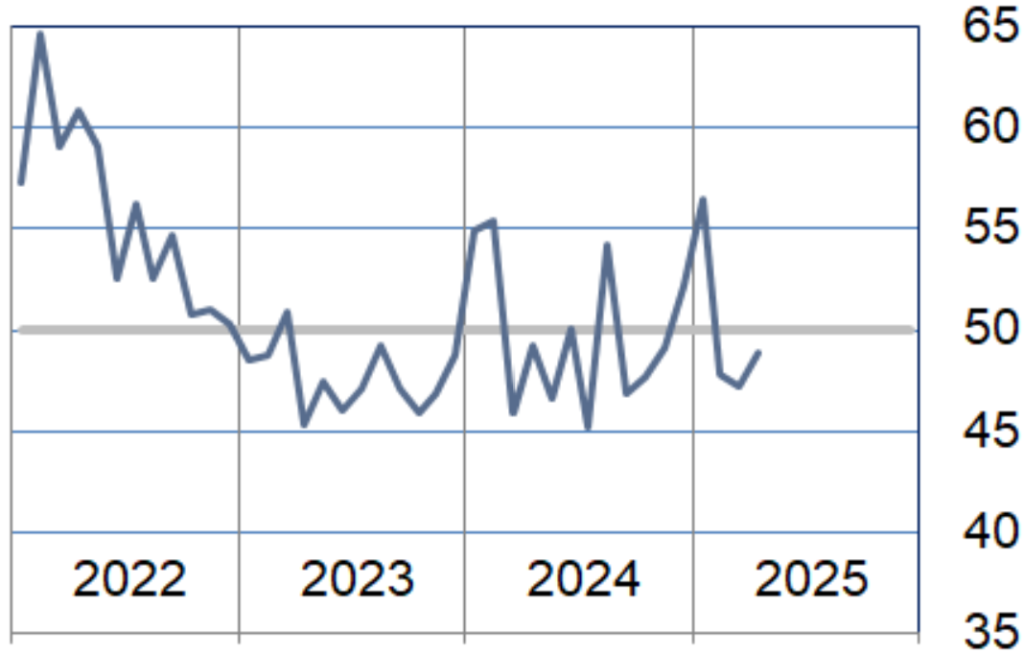
Six Month Projection of Employment Index
The future employment index indicated slight contraction for April. The contraction is driven by both manufacturing and nonmanufacturing sectors.
| Higher | Same | Lower | Net | Index | |
| Nov/24 | 15% | 80% | 5% | 10% | 54.0 |
| Dec/24 | 14% | 81% | 5% | 9% | 52.1 |
| Jan/25 | 13% | 82% | 5% | 8% | 51.3 |
| Feb/25 | 17% | 73% | 10% | 7% | 50.4 |
| Mar/25 | 19% | 71% | 10% | 9% | 50.2 |
| Apr/25 | 13% | 72% | 15% | -2% | 48.5 |

Background on the ISM-Houston Business Report and HPMI Calculation Methods
The Houston Purchasing Managers Index has been included as an integral part of the ISM-Houston Business Report since the Houston chapter of the Institute for Supply Management started publication of this document in January 1995. The report and index are published monthly as the primary deliverables from a survey of Houston area Supply Chain leaders regarding the status of key activities believed to provide insight into the strength of the economy. The respondents come from diverse organizations including construction, energy, engineering, health care, durable and non-durable goods manufacturing, financial and business services, wholesale and retail trade, and utilities related companies.
The Houston Purchasing Managers Index is determined from diffusion indices of the eight indicators of economic activity covered by the ISM-Houston Business Survey and Report. These underlying indicators are sales or new orders, production, employment, purchases, prices paid for major purchases, lead times from sellers, purchased materials inventory (raw materials and supplies), and finished goods inventories. The respondents to the survey report the direction of each these activities as either up, the same or down in comparison to the previous month. An index for each of these areas is then calculated by subtracting the percentage of respondents that sight a negative shift from the percentage that sight a positive shift. For indicators that are positively correlated with economic growth, this results in an underlying index that points to expansion when it is above zero. Indicators that are negatively correlated with growth point to expansion when they are below zero.
The final Houston PMI is calculated by applying optimal regression factors to each of the eight underlying indicators noted above. These regression factors are determined using standard regression techniques comparing these underlying indicators to the Houston-The Woodlands-Sugar Land Business Cycle Index (Houston BCI), which is reported on a monthly basis by the Federal Reserve Bank of Dallas. This top-level index is converted to a 0 to 100 scale to match that of the national Purchasing Managers Index® (PMI®) which is published monthly by the Institute for Supply Management® (ISM®). Readings over 50 for the HPMI generally indicate manufacturing expansion in the Houston in the near term and readings below 50 show coming manufacturing contraction.
It is important to note that the manufacturing breakeven HPMI does not equate to the breakeven point for the overall Houston economy. ISM-Houston periodically reviews the capability of its correlations and adjusts the regression factors when appropriate. The most recent revision occurred as a result of a review undertaken during the third quarter of 2018, which determined that changes in the Houston economy over the last decade have shifted the intercept of the correlation, causing a neutral Houston PMI to no longer align with a neutral Houston BCI. A Houston PMI of 45 points now equates to a neutral Houston economy as measured by the Houston BCI. A similar offset between the National PMI and the National economy has existed for some time.
Use of ISM-Houston Business Report Content
All information contained in this report is protected by copyright laws and ISM-Houston retains all rights to this Content. ISM-Houston hereby grants you a limited, revocable license to access, print, and display this Content solely for your personal, non-commercial use. Requests for permission to reproduce or redistribute ISM-Houston Business Report Content can be made by contacting the ISM-Houston Business Survey Committee at hpmi@ism-houston.org.
ISM-Houston shall not have any liability, duty, or obligation for or relating to the ISM-Houston Business Report Content or other information contained herein, any errors, inaccuracies, omissions or delays in providing any ISM-Houston Business Report Content, or for any actions taken in reliance thereon. In no event shall ISM-Houston be liable for any special, incidental, or consequential damages, arising out of the use of the ISM-Houston Business Report.